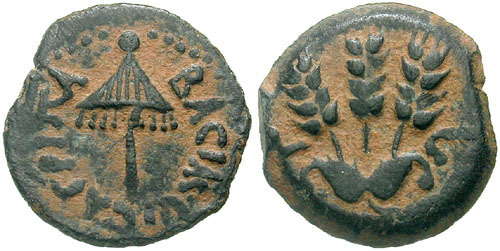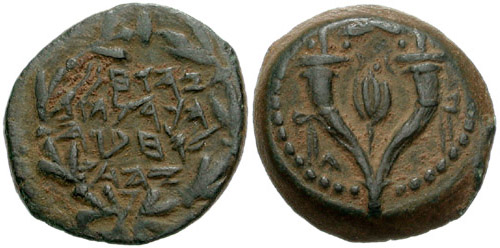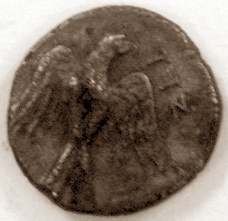|
Prutah
Prutah (Hebrew: פרוטה) is a Hebrew term, possibly derived from Aramaic. It refers to a small denomination coin. History Antiquity The prutah was an ancient copper Jewish coin with low value. A loaf of bread in ancient times was worth about 10 ''prutot'' (plural of prutah). One prutah was also worth two lepta (singular lepton), which was the smallest denomination minted by the Hasmonean and Herodian Dynasty kings. Prutot were also minted by the Roman Procurators of the Province of Judea, and later were minted by the Jews during the First Jewish Revolt (sometimes called 'Masada coins'). State of Israel [...More Info...] [...Related Items...] OR: [Wikipedia] [Google] [Baidu] |
Israeli Pound
The pound or lira ( he, לירה ישראלית ''Lira Yisra'elit'', ar, جنيه إسرائيلي ''Junayh ʾIsrāʾīlī''; abbreviation: IL in Latin alphabet, Latin, ל"י in Hebrew script, Hebrew; code ) was the currency of the Israel, State of Israel from 9 June 1952 until 23 February 1980. The Israeli pound replaced the Palestine pound and was initially pegged at par to £1 pound sterling, sterling. It was replaced by the Old Israeli shekel, shekel on 24 February 1980, at the rate of IS 1 = IL 10, which was in turn replaced by the Israeli new shekel, new shekel in 1985. Before the new currency was brought in, the Anglo-Palestine Bank issued banknotes denominated in Palestine pounds. They were in Hebrew (''lira E.Y.'' i.e. ''lira Eretz-Yisraelit'') and Arabic language, Arabic ''junayh filisṭīnī'' (). On 1 May 1951, all the assets and liabilities of the Anglo Palestine Bank were transferred to a new company called Bank Leumi Le-Yisrael (Israel National Ba ... [...More Info...] [...Related Items...] OR: [Wikipedia] [Google] [Baidu] |
Palestine Pound
The Palestine pound ( ar, جُنَيْه فِلَسْطَينِيّ, ; he, פוּנְט פַּלֶשְׂתִינָאִי (א״י), funt palestina'i (eretz-yisra'eli) or he, לירה (א״י), lira eretz-yisra'elit, link=no; Sign: £P) was the currency of the British Mandate of Palestine from 1 November 1927 to 14 May 1948, and of the State of Israel between 15 May 1948 and 23 June 1952, when it was replaced with the Israeli lira. The Palestine pound was also the currency of Transjordan until 1949 when it was replaced by the Jordanian dinar, and remained in usage in the West Bank of Jordan until 1950. In the Gaza Strip, the Palestine pound continued to circulate until April 1951, when it was replaced by the Egyptian pound. History Until 1918, Palestine was an integral part of the Ottoman Empire and therefore used its currency, the Ottoman lira. During 1917 and 1918, Palestine was occupied by the British army, who set up a military administration. The official currency was the ... [...More Info...] [...Related Items...] OR: [Wikipedia] [Google] [Baidu] |
Herodian Coinage
Herodian coinage were coins minted and issued by the Herodian Dynasty, Jews of Idumean descent who ruled the province of Judaea between 37 BC–92 AD. The dynasty was founded by Herod the Great who was the son of Antipater, a powerful official under the Hasmonean King Hyrcanus II. Herod the Great 37–4 BC The coinage of Herod the Great continued the Jewish tradition of not depicting a graven image. However, a prutah of Herod was the first coin since the Persian period to depict a living creature - an eagle, which may have been an allusion to the golden eagle that Herod erected over the entrance to the Second Temple, and which caused such great offence to the Jews. Other objects depicted on coins of Herod include a winged caduceus and pomegranate ('rimmôn'), one of the seven species mentioned in the Bible as blessings to the Land of Israel, a plumed helmet and shield, a ship's stern and a palm branch. The largest denomination coin issued by Herod, bears a ... [...More Info...] [...Related Items...] OR: [Wikipedia] [Google] [Baidu] |
Roman Procurator Coinage
The procuratorial coinage of Roman Judaea was minted by the prefects and procurators of the province between AD 6 and 66 in only one denomination and size, the bronze prutah. Not all of the Procurators issued coinage. Those that did were Coponius, Marcus Ambivulus, Valerius Gratus, Pontius Pilate, Antonius Felix and Porcius Festus, who between them issued a total of 19 different coins. The last three Procurators Lucceius Albinus, Gessius Florus and Marcus Antonius Julianus didn't issue any coins as the tidings of the First Jewish-Roman War was in the air and the leaders of the revolt started issuing their own coins. Coponius Coponius was the first Roman Prefect of Judaea, being appointed in 6 AD when Herod Archelaus, the son of Herod the Great, was deposed and banished to Gaul by Augustus. Coponius depicted the palm tree bearing two bunches of dates on his coinage, which previously had appeared only on extremely rare coins of Herod Antipas. The palm tree design was later u ... [...More Info...] [...Related Items...] OR: [Wikipedia] [Google] [Baidu] |
John Hyrcanus
John Hyrcanus (; ''Yōḥānān Hurqanōs''; grc, Ἰωάννης Ὑρκανός, Iōánnēs Hurkanós) was a Hasmonean ( Maccabean) leader and Jewish high priest of the 2nd century BCE (born 164 BCE, reigned from 134 BCE until his death in 104 BCE). In rabbinic literature he is often referred to as ''Yoḥanan Cohen Gadol'' (), "John the High Priest". Name Josephus explains in ''The Jewish War'' that John was also known as "Hyrcanus", but does not explain the reason behind this name. The only other primary source, the Books of the Maccabees, never used this name with respect to John. The single occurrence of the name ''Hyrcanus'' in 2 Maccabees 3:11 refers to a man to whom some of the money in the Temple belonged during the c. 178 BCE visit of Heliodorus. The reason for the name is disputed amongst biblical scholars, with a variety of reasons proposed: * Familial origin in the region of Hyrcania on the Caspian Sea * A Greek regnal name, which would have represented closer ... [...More Info...] [...Related Items...] OR: [Wikipedia] [Google] [Baidu] |
Zuz (coin)
A Zuz (Hebrew-זוז; plural zuzzim Hebrew-זוזים) was an ancient Jewish silver coin struck during the Bar Kochba revolt, as well as a Jewish name for the various types of non-Jewish small silver coinage, used before and after the period of the revolt. The name was used from the Greek era of drachmas, through the Roman era of Denarius, and then as the quarter denomination of Bar Kochba coinage. The Jewish insurrectionists' zuz were overstruck on Roman Imperial denarii or Roman provincial drachmas of Vespasian, Titus, Domitian, Trajan and Hadrian. Four Zuzzim, denarii or drachmas make a Shekel, a Sela or a Tetradrachm. Etymology Several different etymologies have been suggested for the word "zuz": * A corruption of the Greek Zeus, who was the deity portrayed on the reverse of many Seleucid tetradrachms during the latest stages of the Seleucid Empire. *In Hebrew, the word "zuz" means "move", or "to move", so it was called "zuzzim" to show that it was constantly moving around, ... [...More Info...] [...Related Items...] OR: [Wikipedia] [Google] [Baidu] |
List Of Historical Currencies
This is a list of historical currencies. Greece * Aeginian stater (gold) * Corinthian stater (silver) * Aurous * Athenian drachma (silver) *Stater (silver) *Tetradrachm (silver) *Drachma (silver) ** Alexandrian coinage ** Ptolemaic coinage **Seleucid coinage ** Bactrian coinage Ancient Lebanon *Tyrian shekel Ancient Lydia *Stater (electrum and silver) * Trite (coin) (electrum third of a stater) * Hekte (electrum sixth of a stater) **Lydian coin Ancient Persia *Daric (gold) *Sigloi (silver) ** Persian coinage ** Persis coinage **Parthian coinage **Sassanian coinage ** Elymais coinage Ancient Rome *Antoninianus *Argenteus (silver) * As (copper) *Aureus (gold) *Denarius (silver) *Dupondius (bronze) *Follis *Sestertius (bronze) *Solidus (gold) * Talent (silver, gold) *Tremissis (gold) **Roman currency **Roman Imperial currency **Roman Republican currency Ancient Europe *Potin *Stater *Gold coin *Silver coin *Écu *Florin Ancient Israel * Ma'ah (silver) *Prutah (bronze/copper) ** ... [...More Info...] [...Related Items...] OR: [Wikipedia] [Google] [Baidu] |
First Jewish Revolt Coinage
First Jewish Revolt coinage was issued by the Jews after the Zealots captured Jerusalem and the Jewish Temple from the Romans in 66 CE at the beginning of the First Jewish Revolt. The Jewish leaders of the revolt minted their own coins to emphasize their newly obtained independence from Rome. History In the Revolt's first year (66–67 CE), the Jews minted only silver coins, which were struck from the Temple's store of silver. These coins replaced the Tyrian shekel, which had previously been used to pay the Temple tax. The newly minted silver coins included shekels, half-shekels, and quarter-shekels, each being labelled with the year of minting and their denomination. These are the first truly Jewish silver coins, and depict a chalice on the obverse with the year of the revolt above, surrounded by the ancient Hebrew inscription "Shekel of Israel". Three budding pomegranates are featured on the reverse, with the inscription "Jerusalem the Holy". During the second (67–6 ... [...More Info...] [...Related Items...] OR: [Wikipedia] [Google] [Baidu] |
Coins Of Alexander Jannaeus
Hasmonean coinage are the coins minted by the Hasmonean kings. Only bronze coins in various denominations have been found; the smallest being a prutah or a half prutah. Two Roman silver denarii are associated with the Hasmoneans; one has the inscription BACCIVS IVDAEAS; with its exact meaning unclear (short for "BASILEOS IUDAEAS", King Judas?). Both show a man thought to be Yehuda Aristobolus bowing before a camel with a palm branch in his hand. The Hebrew inscriptions found on Hasmonean coins are: *''"Yehochanan Kohen Gadol Chever Hayehudim"'' (Yehochanan the High Priest, Council of the Jews). *''"Yehochanan Kohen Gadol Rosh Chever Hayehudim"'' (Yehochanan the High Priest, Head of the Council of the Jews). *''"Yehonatan Kohen Gadol Chever Hayehudim"'' (Yehonatan the High Priest, Council of the Jews). *''"Yehonatan Hamelech"'' (Yehonatan the King). *''"Yehudah Kohen Gadol Chever Hayehudim"'' (Yehudah the High Priest, Council of the Jews). *''"Malka Aleksandros"'' (King Alexande ... [...More Info...] [...Related Items...] OR: [Wikipedia] [Google] [Baidu] |
Hasmonean Coinage
Hasmonean coinage are the coins minted by the Hasmonean kings. Only bronze coins in various denominations have been found; the smallest being a prutah or a half prutah. Two Roman silver denarii are associated with the Hasmoneans; one has the inscription BACCIVS IVDAEAS; with its exact meaning unclear (short for "BASILEOS IUDAEAS", King Judas?). Both show a man thought to be Yehuda Aristobolus bowing before a camel with a palm branch in his hand. The Hebrew inscriptions found on Hasmonean coins are: *''"Yehochanan Kohen Gadol Chever Hayehudim"'' (Yehochanan the High Priest, Council of the Jews). *''"Yehochanan Kohen Gadol Rosh Chever Hayehudim"'' (Yehochanan the High Priest, Head of the Council of the Jews). *''"Yehonatan Kohen Gadol Chever Hayehudim"'' (Yehonatan the High Priest, Council of the Jews). *''"Yehonatan Hamelech"'' (Yehonatan the King). *''"Yehudah Kohen Gadol Chever Hayehudim"'' (Yehudah the High Priest, Council of the Jews). *''"Malka Aleksandros"'' (King Alexande ... [...More Info...] [...Related Items...] OR: [Wikipedia] [Google] [Baidu] |
Agrippa I Prutah
Agrippa may refer to: People Antiquity * Agrippa (mythology), semi-mythological king of Alba Longa * Agrippa (astronomer), Greek astronomer from the late 1st century * Agrippa the Skeptic, Skeptic philosopher at the end of the 1st century * Agrippa Menenius Lanatus, Roman consul in 503 BC * Marcus Vipsanius Agrippa (63–12 BC), Roman statesman and general, friend and lieutenant of Augustus Caesar * Agrippa Postumus (12 BC–AD 14) * Gaius Fonteius Agrippa, father and son with the same name; the former an accuser of Libo, the latter suffect consul in AD 58 * Decimus Haterius Agrippa, consul in AD 22 * Marcus Asinius Agrippa, consul in AD 25 * Vibulenus Agrippa, committed suicide in the Roman senate in AD 36 * Herod Agrippa, (10 BC–AD 44) grandson of Herod the Great, friend of Claudius * Herod Agrippa II, (AD 27–100), his son * Agrippa Castor, Christian Roman writer of the 2nd century * Julius Agrippa, Centurion of the 2nd century * Marcius Agrippa, slave of the 3rd century wh ... [...More Info...] [...Related Items...] OR: [Wikipedia] [Google] [Baidu] |
Gerah
A gerah () is an ancient Hebrew unit of weight and currency, which, according to the Torah (''Exodus'' 30:13, ''Leviticus'' 27:25, ''Numbers'' 3:47, 18:16), was equivalent to of a standard "sacred" shekel. A gerah is known in Aramaic, and usually in Rabbinic literature, as a ''ma'ah'' (מעה; Mishnah Hebrew ''pl''. ma'ot "מעות" which means "coins"). It was originally a fifth of a denarius or zuz, as seen in the Torah and in Ezekiel (45:12), then became a sixth of a dinar/zuz, such as the coinage of Persian-era Yehud, which came in two denominations: approximately 0.58 gram for the ''ma'ah'' and approximately .29 gram for the half ''ma'ah'' (''chatzi ma'ah''). .58 X 6 = 3.48 grams, which is about the weight of a zuz/denarius based on a 14 gram shekel. The Mishnah (1:1) and Jerusalem Talmud (1:4) in Shekalim discuss whether the ''kalbon'' (agio) which was sometimes required to be added to the half shekel annually levied for the Temple, was a ''"ma'ah"'' or a '' ... [...More Info...] [...Related Items...] OR: [Wikipedia] [Google] [Baidu] |






